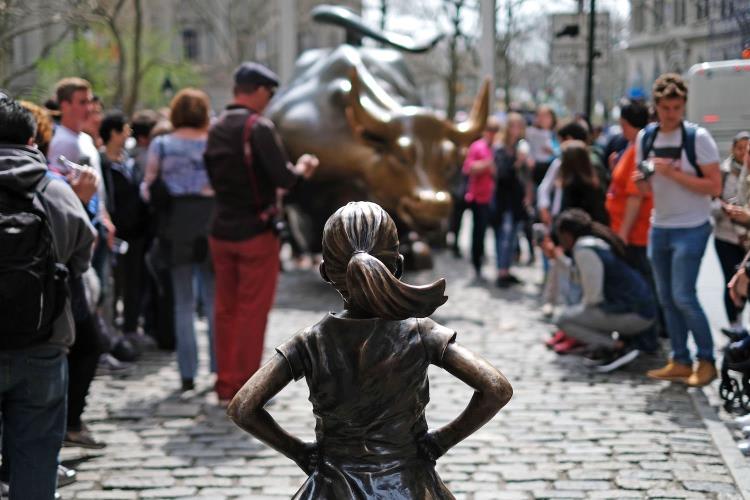Bachelor's degree with a double major in Chinese and Art in Peking University. Master of Art and Administration in New York University. She has served in the Macao Cultural Affairs Bureau, the New York City Department of Cultural Affairs and the Museum of Chinese in America, working as art administrator and curator. She is now working as an art educator and administrator in New York, as well as an independent curator and writer.

Fearless Girl Photo courtesy of Artnet
Last year, a bronze statue in the form of a little girl in New York went viral among the public audience. The short little ponytailed girl, with her hands on her hips, spirited with power, stares down the Wall Street facing the bronze Charging Bull that represents man power and the world of finance. This art portrayal quickly attracted public attention and went viral on social media.
The statue’s commissioning body explained that the statue was set up to encourage financial firms at Wall Street to promote more female employees to the senior managerial level. The sentiment was quickly accepted by the public while very few people know that this third largest asset management company only employs a few female senior executives. Little do people know that originally the male executives of this company wanted to put a cow besides the bull instead of the fearless girl. However, the original proposal was disapproved by the authority and was changed to the current one.
The birth of the fearless girl and the enormous public attention are more or less beyond the company’s expectation. But it didn’t stop them from using the statue to promote a fund with a similar theme, saving an advertisement expense of about over seven million US dollars for the company.
It’s apparent that apart from being an art form, public art still carries the designers’ own intention when entering public space. But since public art has public property, the public’s voice should be heard in the making of artworks. The unexpected turn of event in the making of the fearless girl statue is a living proof of the fact that the people involved in the discussion on the art production would heavily influence the outcome. To strike a balance among different values regarding public arts in society, the public audience and the commissioning body’s full participation into the design discussion proves to be essential.
I have personally participated in a workshop convened by the New York city government’s Percent for Art that aims to simulate panel discussion on a project. In the workshop, different stakeholders would take turn to express their opinions on the matter. A participant in the workshop played the role of a police department delegate in a dramatic way. She kept on rambling that the statue looked gangsta and she as a police department delegate didn’t want to see such artwork to be put in front of the police station....
The entire room burst into laughter after watching her portrayal of the police delegate. Despite the funniness, the director of Percent for Art commented that the scene was actually very realistic. In panel sessions like this, there would always be a pool of diverse opinions, some of which are subjective, some are even narrow-minded. But the goal of the discussion is to provide different voices with the opportunity to express their ideas and concerns, making the ultimate design reflect diverse values.
This process fits the ultimate goal of New York’s Percent for Art, which is to make public arts in New York truly represent the city’s core values: Diversity, creativity, and energy.
At present, Percent for Art, with only three employees, is working to manage over one hundred public art projects submitted to them. The director stated that allowing different stakeholders (commissioning bodies, producers, artists, and the general public) in the public art projects to voice out their opinions during the panel discussion is the strategy to integrate different values and ideas. To make it convenient for communities to participate in the discussion, the panel session would be arranged in residential areas in communities at night as well.
Personally speaking, I appreciate such mechanism that allows the general public to participate into the discussion on public art establishments. On one hand, such mechanism can help to create public arts representing residents’ will. On the other hand, facilitating an environment and mechanism for rational discussion also contributes to the mutual understanding among different stakeholders and values. During this process, the residents’ imagination for their communities is inspired and the unity of the communities is strengthened. These are the hidden benefits that public arts can bring to communities.